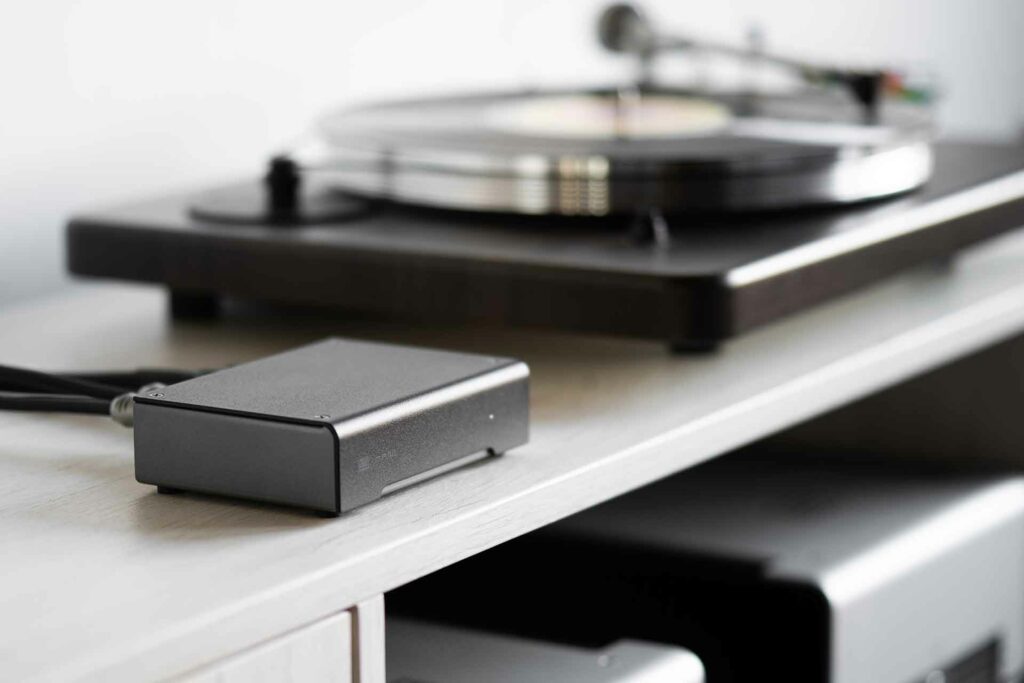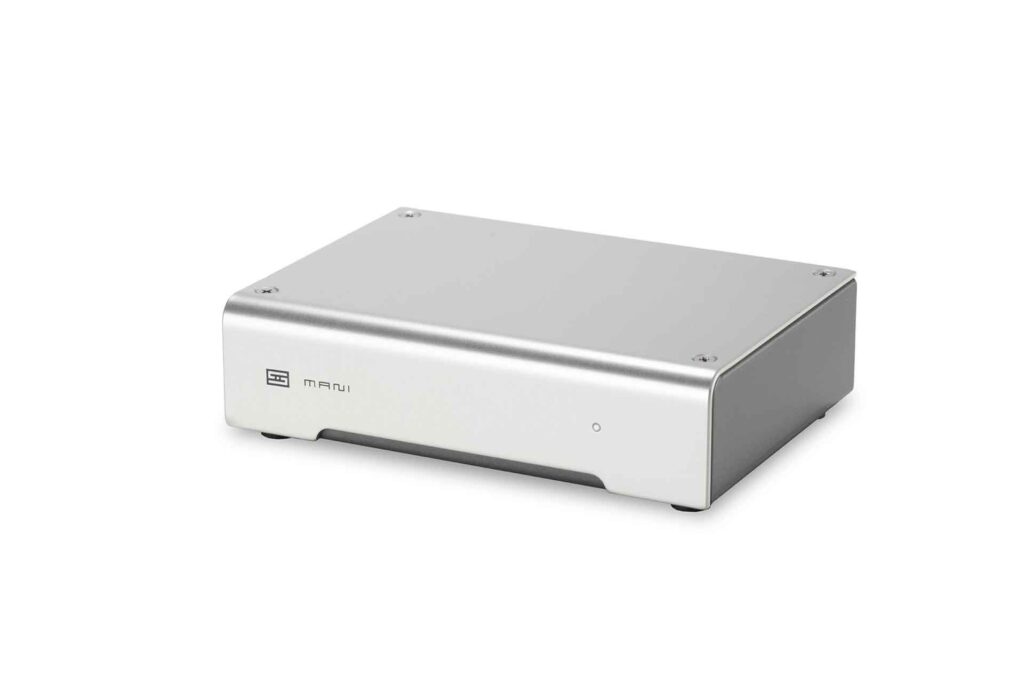“This stuff is the Schiit…” That is how the story started for Schiit Audio in 2010 when Jason Stoddard and Mike Moffett decided to combine their years of industry experience into something new. The USA-made Mani 2 is a phono preamplifier that represents extreme value. Quality turntables, even on the entry-level, need some sort of booster stage to get the signal to the point where the rest of the electronics can “hear” it. The signal also needs to be EQ’d to boost high frequencies and cut low frequencies to compensate for the RIAA curve applied to audio before it’s pressed to vinyl.
Audiophile phono preamplifiers, also known as phono stages, were once built-into most stereo receivers and integrated amplifiers. But not all components these days has dedicated phono inputs, and since phono stages deal with extremely delicate signals that can be mucked up by other electronics, going separate helps reduce noise, increase performance, and deal with all the “nits and nats” required to have an enjoyable experience spinning plastic discs.

What Makes the Mani 2 So Special as a Phono Preamp?
- The Schiit Mani 2 phono preamp (buy at Amazon) provides elegant engineering that yields extremely low distortion. This is the result of a very robust power supply, and a fully passive RIAA network with high quality components.
- The Schiit Mani 2 will handle just about any cartridge and “loading” you can throw at it. Most cartridges are moving magnet or MM, and the Mani 2 comes set up in this configuration. If you are running something a little fancier, like a moving coil (MC) or moving iron (MI) cartridge, you can select just about any configuration you need from the switches on the bottom of the enclosure.
- Selectable LF (low frequency) filtering allows further customization of the sonic experience provided by the Mani 2. This assures problems like foot-fall, and a slightly warped record will not overstrain amplifiers and loudspeakers alike. If you do not desire the filtering, simply turn it off.
- The Mani 2 is designed and assembled in the USA. Schiit sources as much as they can from American suppliers and have full control over the quality and supply chain of their product.

Why Should You Care About the Schiit Mani 2 Phonostage?
Three words: value, value, and value. You can find the same technologies in audio equipment costing over $10,000, but Schiit recognizes the need for high performance equipment that is accessible for the people. This refreshing attitude is basically the opposite of where the audiophile hobby/business has gone in over the past decade. Audio companies need to be smart. They need to simplify, leverage advanced manufacturing techniques and well-thought-out supply chains, and make a meaningful and accessible product for all music lovers. It can be done, and has been done in the Schiit Mani 2.
Listening to vinyl is an experience that is sensitive to the ins and outs of the signal. Many manufacturers “tune” their equipment to sound a certain way. These tunings may be described as “warm,” “lean,” “authoritative,” and all sorts of other adjectives representing the preferred experiences of unique individuals. The Schiit Mani 2 does not seem to have much opinionative coloration and presents the sound in a neutral manner. It is nice to hear what is on an album, as the artist, and ultimately the recording engineer and producer, felt would preserve the message in the music. Since the Mani 2 has extremely low distortion and is dynamically capable, Schiit does not have to hide its flaws behind any sort of special tuning or coloration.
The Schiit Mani 2 is small. At 5 inches wide, by 3.25 inches, standing 1.25 inches tall, it can be tucked anywhere. It is also attractive despite its stamped-steel frame. The top wraps to the front, which makes the Mani handsome enough to show off.

Some Things You Might Not Like About the Schiit Mani 2.
- The wall wart is so clunky. Schiit keeps the Mani 2 physically small by removing the power transformer from the chassis and making it part of the power plug. It is an odd voltage (16 volts) so if your cat chews through the wire, it cannot be easily replaced without a call to Schiit. The power-in is also labeled “AC in” which indicates that it may be a step-down transformer, and not a DC power supply.
- Cognitive dissonance is real. Sometimes we listen with our eyes first and conclude that there is no way a $149 phono stage could perform as well as the Mani 2 does. Too bad brain—the Mani 2 does perform. Exceptionally well. Alas, egos run large in the world of audio. Size of “equipment,” brand names, and one-upmanship mistakenly loom large in importance. Schiit is helping us get over all of those hang-ups.
- The Mani two is well-dressed, but all the connections loosely poke through covers and feel a little cheap. This is all part of the value proposition. Be gentle with your Schiit, people.
Listening to the Schiit Mani 2 Phono Preamp…
Let’s head to the beach, play some bare-footed football, and vibe by the sunset with Jack Johnson. Brushfire Fairytales is Jack’s debut album. It is laid back and well recorded, which is to be expected from a former professional surfer. “Bubbly Toes” is a hoot. Up-beat strumming, a big acoustic drum beat, and bongos dominate the background of Jack’s firm and articulate lyrics. The Mani 2 presented the complexity of this album without leaving much on the table. Clear and listenable midrange, smooth extended highs, and a foundation of quick bass response assured the message of Jack’s music was well preserved.
Back up to about 1986 when Peter Gabriel released what is considered by many to be his greatest work: So. This masterpiece of 80s pop music has a few beautiful hidden gems, along with fan favorites like “In Your Eyes” and “Sledgehammer.”
“Mercy Street” is a personal all-time favorite. It combines a beautiful message, interesting musical themes, ambient atmospheric themes, and a recording that clearly delivers it all.
“Mercy Street” is more complex and subtle than Jack Johnson’s work, and the Mani 2 did not back down from this audiophile challenge. The Mani 2 remained neutral, resolving, and homogeneous across the soundstage. There have been times where the experience of this song has offered more in terms of space between the notes, holographic presentation, and apparent dynamic range. This was through a phono stage that was forty times the Mani 2’s $149 selling price, and through a truly top-tier brand that are masters in crafting a flawless audio experience: Audio Research.
More Resources
• Read Michael Zisserson’s review of the Rega Planar-1 $599 Turntable
• Read Brian Kahn’s review of the Marantz TT-15S1 $1,799 Turntable

Does the Schiit Mani 2 Have Any Resale Value?
The Mani 2 is $149. Not sure it carries much resale since it is so easily had. Many of us give away our Schiit when we upgrade because we can. What does such an affordable phono preamp owe us after a little use? Not much, but if it could help somebody else kickstart their audiophile journey, then all the better, right?
Who Is the Competition For Schiit Mani 2?
Throwing “$149 phono stage” into Google proves that many are trying to get in on the affordable phono preamp game these days. To run through all the options would be silly. The better approach is to list a phono stage that may be considered a meaningful competitor for the Mani 2 in terms of performance and featgures. There are increasing numbers of audiophile Chi-Fi (Chinese made, often off-brand stuff) that are gaining traction but I am still loving the Made-in-America vibe at $149 for an audiophile grade component.
$1,499.99 will land you a Parasound JC 3 Jr. in your audio system. The JC3 Jr. offers the same ability to adapt to any phono cartridge, and when reflecting on phono stages, it may be the place where you start to get noticeably more performance for your audiophile phono investment.
Final Thoughts on the Schiit Mani 2 Phono Preamp…
Schiit cuts out the middle-man, which helps keep the price of the Mani 2 at an ultra-affordable $149. The Schiit Mani 2 is an exceptional value that helps make high fidelity audio accessible to all… as it should be. The neutral sonic presentation and remarkably delicate resolution will make anyone’s vinyl collection have the gravitas a music enthusiast is looking for. The Schiit Mani 2’s flexibility also will appeal to the audiophile tweaker who cannot just leave good enough alone by allowing a range of turntable and cartridge functionality and flexibility that is typical of much higher price points. This is the type of audiophile product that makes you feel good about the future of the hobby and one that will leave the elders who sell the idea that “more expensive is always better” adjusting their hearing aids.



